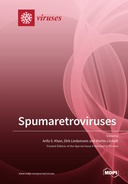Explore

Spumaretroviruses
0 Ungluers have
Faved this Work
Login to Fave
Foamy viruses, currently referred to as spumaretroviruses, are the most ancient retroviruses as evidenced by traces of viral sequences dispersed in all vertebrate classes from fish to mammals. Additionally, infectious foamy viruses circulate in a variety of mammalian species including simian, bovine, equine, caprine, and feline. Foamy viruses have many unique features which led to the division of the retrovirus family into two subfamilies, the Orthoretrovirinae and Spumaretrovirinae. In vitro, foamy viruses have a broad host range and in vivo, human infections have been described due to cross-species transmission from infected nonhuman primates. Thus far, there are no reports of virus-induced disease in humans or in the natural host species. These unique properties of foamy viruses have led researchers to develop foamy viruses as gene therapy vectors to study virus–virus and virus–host interactions for identifying factors involved in virus replication, transmission, and immune regulation that could influence potential clinical outcomes in humans as well as for using endogenous foamy virus sequences in the analysis of host species evolution.
This book is included in DOAB.
Why read this book? Have your say.
You must be logged in to comment.
Rights Information
Are you the author or publisher of this work? If so, you can claim it as yours by registering as an Unglue.it rights holder.Downloads
This work has been downloaded 90 times via unglue.it ebook links.
- 90 - pdf (CC BY) at Unglue.it.
Keywords
- ancient retroviruses
- animal experiment
- animal model
- ANKRD17
- antiviral drugs
- antiviral host restriction
- BFV
- Bif1 (SH3GLB1)
- Biology, Life Sciences
- bovine foamy virus
- Brazil
- Cats
- cell-free transmission
- cGAS
- Chronic Kidney Disease
- chronic renal disease
- Co-Evolution
- co-infections
- co-speciation
- complete viral genome
- cross-species virus transmission
- cytopathic effect
- ELISA
- endogenous foamy virus
- endogenous retrovirus
- Epidemiology
- equine foamy virus
- European bison
- fallow deer
- feline foamy virus
- feline illness
- foamy virus
- foamy virus vector
- foamy virus-host interactions
- foamy viruses
- free-living primates
- FV gene transfer to HSCs
- FV vectors
- Gene expression
- gene marking
- Gene Therapy
- gene therapy alternatives
- gibbon
- hematopoietic stem and progenitor cells
- high-throughput sequencing
- HSC
- Immune responses
- in-vivo gene therapy
- Infection
- infectious clone
- innate immunity
- innate sensing
- integrase
- Integration
- inter-species transmission
- Isolation
- Japan
- Kidney
- latent infection
- lesser apes
- Life sciences: general issues
- Mathematics & science
- medicine
- miRNA expression
- miRNA function
- miRNA target gene identification
- model system
- mountain lion
- neglected virus
- Neotropical primates
- Neurosciences
- new world primates
- NHP
- particle release
- Pathogenesis
- pre-clinical canine model
- protease
- proviral load
- Puma concolor
- Red deer
- replication in vitro
- replication kinetics
- reptile foamy virus
- Resistance
- restriction factors
- Retrovirus
- reverse transcriptase
- reverse transcriptase activity
- Reverse transcription
- RNase H
- roe deer
- SCID-X1
- sero-epidemiology
- seroreactivity
- serotype
- simian foamy virus
- simian retrovirus
- spuma virus
- spumaretrovirus
- spumavirus
- STING
- viral prevalence
- viral tropism
- virus replication
- virus-host-interaction
- wild ruminants
- zoonoses
- zoonosis
Links
DOI: 10.3390/books978-3-0365-0595-4Editions

